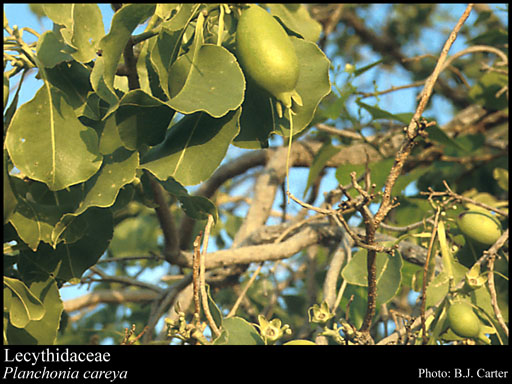- Reference
- Dict.Class.Hist.Nat. 9:259 (1825)
- Name Status
- Current

Scientific Description
Family Sometimes included in Barringtoniaceae.
Habit and leaf form. Trees, or shrubs (rarely). Leaves alternate; spiral (but often pseudoverticillate or tufted); petiolate; not gland-dotted; simple. Leaf blades entire; usually oblanceolate; pinnately veined; cross-venulate. Leaves without stipules. Leaf blade margins entire, or crenate, or dentate. Stem anatomy. Secondary thickening developing from a conventional cambial ring.
Reproductive type, pollination. Fertile flowers hermaphrodite. Unisexual flowers absent. Plants hermaphrodite.
Inflorescence and flower features. Flowers aggregated in ‘inflorescences’; in racemes, or in corymbs. Inflorescences racemes or corymbs, often elongated. Flowers medium-sized to large; regular to very irregular; when irregular, asymmetric. The floral asymmetry involving the androecium, or involving the perianth and involving the androecium. Flowers cyclic; pentacyclic, or polycyclic. Free hypanthium present to absent. Perianth with distinct calyx and corolla; (6–)8–12; 2 -whorled; isomerous. Calyx (2–)4(–6); 1 -whorled; polysepalous, or gamosepalous; when gamosepalous, blunt-lobed; imbricate (rarely closed). Corolla 4(–6); 1 -whorled; polypetalous, or gamopetalous (sometimes fused to the staminal cup); imbricate. Androecium 50–100 (or more — i.e. ‘many’, giving the flowers a fluffy, myrtaceous appearance). Androecial members maturing centrifugally; free of the perianth, or adnate (to the corolla); coherent (the filaments basally united, usually in several series, often concentrated on one side of the flower by abortion of members); 1–20 - adelphous (to ‘polyadelphous’); 3–5 -whorled (‘in several series’). Stamens 20–100 (‘many’); polystemonous. Anthers basifixed; dehiscing via longitudinal slits; latrorse; tetrasporangiate. Gynoecium 2–4(–6) carpelled. The pistil 2–4(–6) celled. Carpels reduced in number relative to the perianth to isomerous with the perianth. Gynoecium syncarpous; eu-syncarpous; inferior. Ovary plurilocular; 2–4(–6) locular. Epigynous disk present. Gynoecium stylate. Styles 1; apical. Stigmas 1. Placentation axile to apical. Ovules 2–50 per locule (to ‘many’); anatropous.
Fruit and seed features. Fruit dehiscent, or indehiscent; capsular-indehiscent (then broadly 4-winged), or a berry (then fibrous, usually one-seeded), or a capsule. Capsules sometimes circumscissile. Seeds non-endospermic; often woody and large. Embryo well differentiated.
Geography, cytology, number of species. Paleotropical. World distribution: palaeotropical. X = 13. 53 species.
Keys
Western Australian Genera and Families of Flowering Plants — an interactive key
T.D. Macfarlane, L. Watson, N.G. Marchant